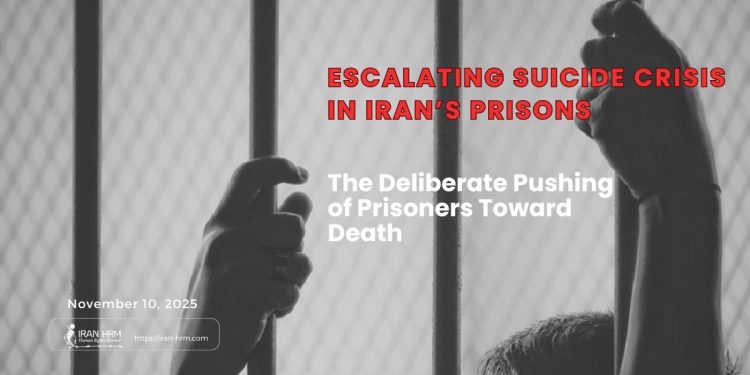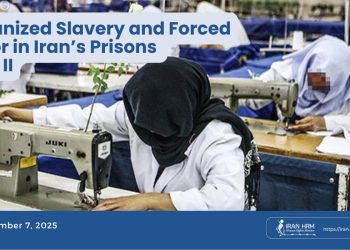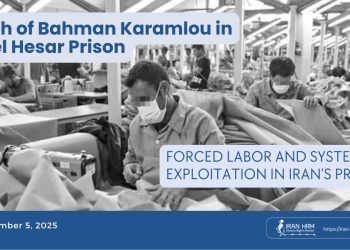The death of Ali Mirza Niazi in Vakilabad Prison, Mashhad, on 6 November 2023, once again exposed the depth of the escalating suicide crisis inside Iran’s prisons. Niazi was left without medical intervention for hours after ingesting methadone and pills, and was transferred to hospital only when it was already too late. Weeks earlier, in Qezel Hesar Prison in Karaj, Mohammad Koushki died under similar circumstances after swallowing drugs without receiving timely treatment. These cases are part of a persistent pattern in which prisoners in critical condition are not protected, but instead effectively abandoned at the point where intervention is most vital.
In some cases, the link between violence, psychological collapse and death is even more explicit. In Hamedan Prison, Hossein Karimabadi, who had slit his throat and required immediate medical care, was not transferred to a hospital but instead taken directly to be executed. Such cases illustrate how death in custody is not an isolated occurrence but the predictable outcome of a coercive and punitive system. This report examines the available evidence and outlines the structures and practices through which prisoners are systematically pushed toward death.
Context and Scale of the Crisis
In recent years, Iran’s prisons have evolved into environments defined by chronic psychological pressure, violence and institutional breakdown. Severe overcrowding, prolonged solitary confinement, restricted family visits, repeated security interrogations, denial of medical care, threats and humiliation together form a system that erodes the physical and mental integrity of prisoners.
Lakan Prison in Rasht represents one of the most alarming examples. In November 2023 alone, 20 prisoners attempted suicide, including 11 through cutting their veins, while others used dangerous drugs. During the same month, Sohrab Azadbar died after ingesting methadone. This monthly figure shows that suicide is not an individual reaction but a direct consequence of structural and deliberate pressures.
Similar patterns have been reported in Vakilabad (Mashhad), Qezel Hesar (Karaj), Urmia, Bookan, Greater Tehran Prison, and Hamedan. Across these facilities, suicide attempts appear as the end point of continuous coercion, where prisoners—especially political detainees—are placed under conditions that offer no lawful or safe avenue for redress.
A detailed list of documented suicide cases across these prisons is provided in Appendix Tables 1–5.
Patterns and Death-Inducing Practices
Solitary confinement is systematically used as a tool of psychological control. Long-term isolation, denial of visits, intimidation and constant surveillance sever prisoners from any emotional support system. In the case of Hamzeh Darvish, repeated solitary confinement, new fabricated charges and ongoing threats pushed him repeatedly toward suicidal actions.
Repeated cases show that prisoners who ingest dangerous substances or attempt suicide are not provided immediate medical care. This deliberate inaction was evident in the deaths of Niazi and Koushki. Reports from Urmia, Greater Tehran Prison and Karaj describe a consistent pattern in which medical intervention is withheld, delayed or conditioned on punitive measures—transforming medical neglect into an intentional method of coercion.
In several prisons, suicide attempts occur directly after beatings, humiliation or sexual violence. The death of Payam Sattari in Bookan, following reports of severe abuse and assault, and the suicide attempts of Farhad and Fardin Aghazadeh in Urmia after being beaten, demonstrate how torture can become the immediate trigger for self-harm.
One of the most alarming pieces of evidence comes from Hamzeh Darvish’s third letter to the UN Special Rapporteur. He stated that officials told him, “There are easier ways to kill yourself,” and detailed the distribution of propranolol—a drug lethal in high doses—encouraging prisoners to use it. He reported that nine prisoners in Ward 8 of Lakan Prison died after being given such medication.
Heavy sentences, fabricated charges, prolonged uncertainty and the constant threat of new prosecutions create unbearable psychological strain.
For case-by-case data supporting these findings, see Appendix Tables 1–5.
Key Case Studies
The deaths of Ali Mirza Niazi and Mohammad Koushki illustrate how deliberate delays or refusals of medical care directly enable preventable deaths.
In cases such as those involving Payam Sattari or the Aghazadeh brothers, suicide attempts occurred following physical assault. These deaths reflect the merging of torture and self-harm within the same sequence of coercion.
Darvish’s accounts—detailing threats, dangerous medication, solitary confinement and repeated interrogations—constitute one of the clearest documented examples of a prisoner being systematically pushed toward death.
Karimabadi’s execution while in medical emergency demonstrates an extreme form of violating the right to life.
The deaths of Kianoosh Sanjari and Yalda Aghafazeli highlight the long-term effects of trauma extending beyond imprisonment.
Legal Assessment
Iran is obligated under international human rights law to protect the life, health and physical integrity of detainees. Solitary confinement, deliberate denial of medical care, encouragement of suicide, torture, and concealing causes of death constitute clear violations of the right to life, the prohibition of torture, and the Mandela Rules requiring immediate investigation of deaths in custody.
The documented patterns demonstrate systemic violations embedded within institutional structures.
Conclusion
The evidence shows that suicide in Iran’s prisons is the outcome of structural pressures, punitive practices and death-inducing policies. From Lakan in Rasht to Mashhad, Karaj, Urmia and Hamedan, consistent patterns emerge: solitary confinement, absence of medical care, torture, threats, dangerous medication and judicial coercion create conditions in which prisoners are systematically pushed toward death.
Addressing this crisis requires transparency, independent monitoring and dismantling the structures that turn the lives of prisoners into instruments of control.
Appendix: Documented Suicide and Death Cases in Iranian Prisons
Table 1 – Confirmed Suicides in Custody
| Nr | Full Name | Age | Prison / City | Date (Gregorian) | Method | Case Type | Notes |
| 1 | Ali Mirza Niazi | 39 | Vakilabad Prison, Mashhad | 2025-11-06 (15 Aban 1404) | Ingestion of pills + methadone | Death row | Died hours after hospital transfer |
| 2 | Hamid Khosravi | — | Karaj Central Prison | 2024-02-06 (17 Bahman 1402) | Methadone overdose | Ordinary | Delayed transfer; death confirmed |
| 3 | Mohammad Koushki | — | Qezel Hesar Prison, Karaj | 2024-12-25 (5 Dey 1403) | Methamphetamine ingestion | Ordinary | Died the same day |
| 4 | Hadi Rezaei | — | Qezel Hesar Prison | — | Drug ingestion | Ordinary | Limited information available |
| 5 | Hossein Karimabadi | — | Hamedan | — | Self-harm prior to execution | Ordinary | Injured, then executed |
| 6 | Unnamed financial prisoner | — | Greater Tehran Prison | 2024-02-07 (18 Bahman 1402) | Self-immolation with alcohol | Financial | Severe financial pressure |
Table 2 – Suspicious Suicides Linked to Torture or Abuse
| Nr | Full Name | Age | Prison / City | Date (Gregorian) | Cause / Pressure | Summary |
| 1 | Payam Sattari | — | Boukan | — | Torture, sexual assault, threats | Death under highly suspicious circumstances |
| 2 | Farhad Aghazadeh | — | Urmia | 2024-10-17 (26 Mehr 1403) | Beatings + solitary confinement | Attempted suicide after torture |
| 3 | Fardin Aghazadeh | — | Urmia | 2024-10-17 (26 Mehr 1403) | Beatings + solitary confinement | Heavy bleeding; condition unknown |
| 4 | Unnamed amputee prisoner | — | Urmia | — | Sentence of amputation | Suicide attempt in protest of inhuman punishment |
Table 3 – Suicide Attempts as Protest (Survived)
| Nr | Full Name | Prison / City | Date (Gregorian) | Method | Case Type | Cause / Pressure |
| 1 | Hamzeh Darvish | Lakan Prison, Rasht | 2023-08-10 / 2023-08-11 (19–20 Mordad 1402) | Ingestion of 14 pills | Political / Conscience | New fabricated case, solitary confinement, denied visits |
| 2 | Hamzeh Darvish (second case) | Lakan Prison, Rasht | — | Threatened self-harm | Political | Explicit encouragement to “commit suicide” by prison officer |
| 3 | Hamidreza Sahl-Abadi | Tehran | 2024-07-24 (3 Mordad 1403) | Ingestion of pills | Political | New fabricated charges; risk of long-term sentence |
| 4 | Javad Mohammadi-far | Urmia | — | Attempted hanging | Political | Complete denial of medical care (suspected stomach cancer) |
| 5 | Siamak Moghimi | Fashafuyeh | — (Esfand 1398) | Wrist-cutting | Political (Nov 2019 protests) | Protest against humiliation and denial of rights |
| 6 | Unnamed prisoner | Khorramabad | 2024-02-06 / 07 (18 Bahman 1402) | Wrist-cutting | Ordinary | Medical neglect and delayed transfer |
Table 4 – Post-Release Suicides Linked to Detention Trauma
| Nr | Full Name | Location of Death | Detention Background | Date (Gregorian) | Case Context | Summary |
| 1 | Kianoush Sanjari | Tehran – Charsou Bazaar | Multiple arrests, solitary confinement (Ward 209) | 2024-10–11 (Aban 1403, exact day not stated) | Political / Journalist | Symbolic protest suicide against repression |
| 2 | Yalda Aghafazli | — | Detained during 2022 uprising | — | Social–political | Death linked to severe psychological trauma |
Table 5 – Prisoners at High Risk of Suicide (Urgent Monitoring)
| Nr | Full Name | Prison | Case Type | Risk Factors | Evidence |
| 1 | Hamzeh Darvish | Lakan Prison, Rasht | Political / Conscience | Solitary confinement, fabricated charges, threats, no visits | Multiple suicide attempts |
| 2 | Javad Mohammadi-far | Urmia | Political | Severe illness + denial of treatment | Attempted hanging |
| 3 | Hamidreza Sahl-Abadi | Tehran | Political | Legal uncertainty, pressure, new charges | Suicide attempt |
| 4 | Prisoners of Urmia “secret ward” | Urmia | Ordinary | Torture, no beds, no visits | Multiple suicide attempts reported |







